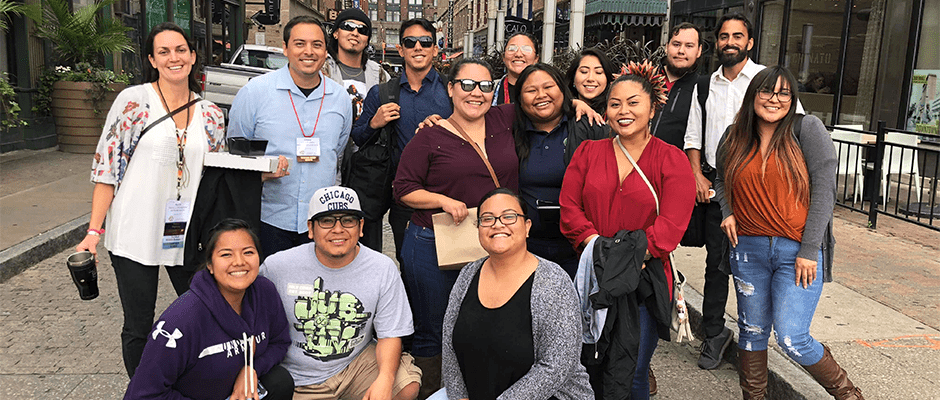Share this article
Grant helps native students attend TWS conference
Eleven native students took advantage of networking and learning opportunities at the annual TWS conference in Cleveland thanks to Native Student Professional Development Program (NSPD) grants.
The program started in 2006 and has brought 120 students to TWS annual conferences. Organized by the Native People’s Wildlife Management Group, the NSPD program aims to support indigenous students going into the wildlife field. They hope this also plays a role in increasing cultural diversity in the wildlife profession.
“The purpose is to introduce them to The Wildlife Society and allow them a weeklong experience to increase their professional development and be able to network with folks that attend TWS,” said Serra Hoagland, chair of the Native People’s Working Group and coordinator for the Native Student Professional Development Program. “It also is supposed to bring them together as a cohort.”
Grant recipients must be a current student or recent graduate and must be pursuing a career in natural resources. “They submit a personal essay where they talk about their interest in the wildlife field, what their career goals are and then how they can bring their culture to the organization,” Hoagland said.
For the students who were accepted, Hoagland developed a detailed schedule of events they should attend, but she also gave them time to choose where they wanted to go and to meet up with other native students.
“I honestly loved the native symposium,” said Sabrina Suluai-Muhaka, a graduate student at the University of Hawaii at Manoa, who is from American Samoa. “They were talking about how each native group of people is trying to sustain food, working with wildlife. It was really amazing to hear from everyone’s perspective. It’s entirely different here, but there are similar struggles. It’s interesting to hear their point of view, working together as a community.”
Suluai-Muhaka teaches at youth programs on the island and hopes to incorporate what she learned at the conference. She also teaches high school English. After coming back from the conference, she said she brought back brochures and other information from the conference to share with her students about the different opportunities for Pacific Islanders to get involved in wildlife and environmental issues.
Other students appreciated The Wildlife Society taking action to promote diversity. “My favorite part of the conference was getting to meet the all people in the Native People’s Wildlife Management Working Group,” said Brandon Kittson, a student at Salish Kootenai College in Pablo, Montana. “I liked that fact The Wildlife Society is working to promote diversity within the organization. I also really enjoyed the symposium on tribal food sovereignty. This opportunity was extremely beneficial because it allowed me to meet some really awesome people and expand my network and learn about some scholarships and grad school opportunities.”
Hoagland said for many of the students, this is their first introduction to The Wildlife Society, although some may be involved in student chapters or at the local level. She hopes students are encouraged to become more involved at a national level. One participant, Michael Jordan from the San Carlos Apache Reservation in Arizona was introduced to TWS council and said, “I want to see myself sitting at that table one day.”
Hoagland said one of the best parts of the program is the native students getting to know each other and staying in touch after the conference. “It’s a good opportunity to feel that network of a cohesive group,” she said. “A lot of them end up being friends on social media. Now I get to see them encourage each other on finals and midterms and working on projects, preparing for the next meeting. It’s kind of neat to see them maintain the friendship and connections at events.”
While Hoagland is stepping down from coordinating the program next year after five years, and new program coordinator Ty Werdel, a PhD student at Kansas State and past NSPD recipient, will be taking over, she hopes to continue to see success in the program in years to come.
And Suluai-Muhaka is also already thinking about sharing the great experience she had with her past students next year. “I’m actually recruiting,” she said. “Because some of the college students are my former students, I’m getting in contact with them and saying ‘apply for this opportunity!’”
The following students or recent graduates participated in the Native Student Professional Development Program this year:
Riley Etcitty, Navajo
Mikelle Ivins, White Mountain Apache
Michael Jordan, San Carlos Apache
Brandon Kittson, Blackfeet
Eric Laate, Zuni Pueblo
Koa Matsuoka, Native Hawaiian
Michelle Quillin, Hughes Village (Alaska)
Jeromalyn Santos, Pacific Islander (Saipan)
Sabirna Suluai-Muhaka, Native Hawaiian
Nerisa Taua, Pacific Islander (Samoan)
Sattie Whitefoot, Yakama
The Native Student Professional Development Program was supported by the following organizations and partners:
Little River Band of Ottawa Indians
National Wildlife Research Center
Shakopee Mdewakanton Sioux Community
U.S. Forest Service
U.S. Fish & Wildlife Service
Header Image: Members of the Native Student Professional Development Program enjoy each other’s company at the annual TWS conference in Cleveland. Image courtesy of Sabrina Suluai-Muhaka.








